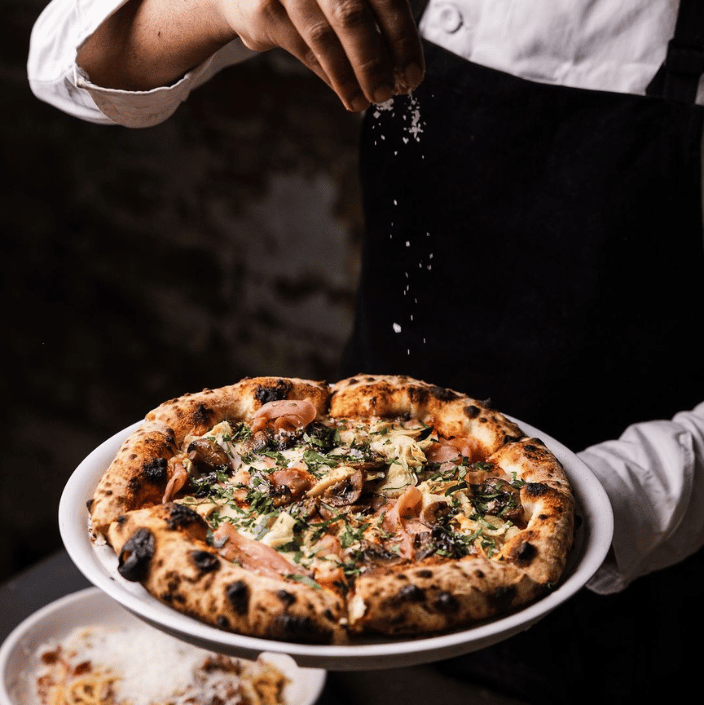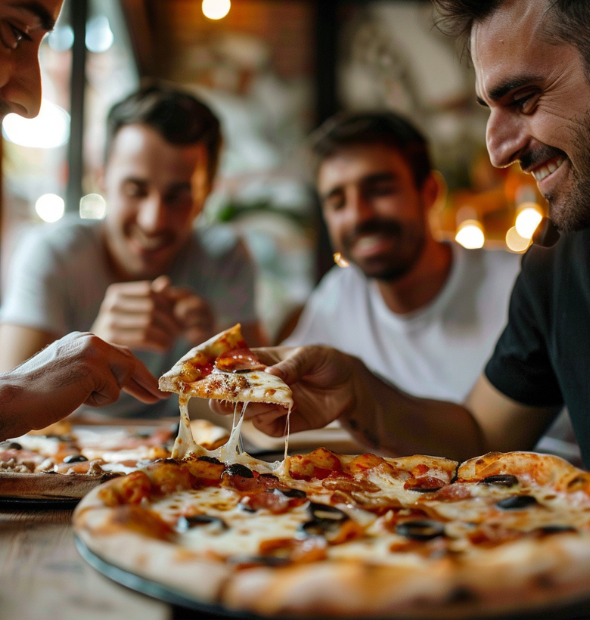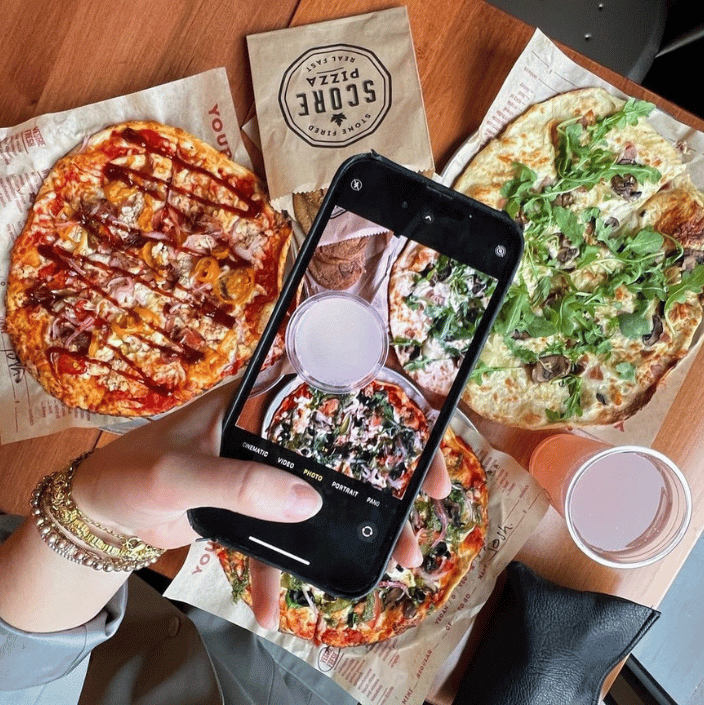Pizza and Men: A Historical Love Affair
Pizza has become one of the most beloved and iconic foods around the world. Its popularity knows no bounds, but have you ever wondered about the historical connection between pizza and men? This article delves into the intriguing relationship between pizza and the male gender throughout history, shedding light on the cultural impact it has had.
The origins of pizza date back centuries, with its roots traced to various regions across the globe. While it remains a topic of debate, many believe that pizza was first made in Naples, Italy in the late 18th century. The concept of flatbreads topped with various ingredients can be found in ancient cultures, such as ancient Egypt and Greece.
The rise of pizza’s popularity, particularly in America, can be attributed to various factors. It wasn’t until the late 19th and early 20th century, with the influx of Italian immigrants, that pizza gained recognition in the United States. These immigrants, predominantly men, brought their culinary traditions and skills with them, establishing pizzerias and introducing Americans to the delicious flavors of pizza.

Pizza quickly became associated with masculinity, with men playing a significant role in popularizing and spreading its love. Pizzerias became gathering places for men, where they could enjoy a satisfying meal and socialize with friends. This association between pizza and men has been perpetuated in popular culture, media, and advertising, reinforcing gender stereotypes and creating a certain image of masculinity.
Today, pizza continues to hold symbolic significance in relation to masculinity. It is often portrayed as a “man’s food,” perpetuating the idea that men are hearty eaters and pizza is their indulgence. This cultural connection has influenced media representation, with pizza being used as a prop to convey masculinity in movies, TV shows, and advertisements.
The impact of the pizza and men connection goes beyond mere stereotypes. It shapes perceptions, influences consumer behavior, and contributes to societal norms. Understanding this historical love affair between pizza and men provides insight into the cultural influences that shape our relationship with food and gender.
In the following sections, we will delve deeper into the reasons behind the association between pizza and men, explore how it reinforces gender stereotypes, examine the symbolic significance of pizza in relation to masculinity, and discuss the broader cultural impact of this connection.
Key Takeaways:
- The Origins of Pizza: Pizza has a long and interesting history, originating in ancient times and gaining popularity worldwide.
- The Rise of Pizza’s Popularity: Pizza became popular in America through waves of immigration and the influence of Italian-American communities.
- Pizza and Male Stereotypes: Pizza has often been associated with men, perpetuating gender stereotypes through its portrayal in media and advertising.
The Origins of Pizza
The origins of pizza can be traced back to ancient civilizations in the Mediterranean region, particularly the Greeks and Romans.
It is believed that the concept of pizza was first developed by the ancient Greeks, who baked flatbreads with olive oil and local spices.
These early versions of pizza were simple and lacked the toppings we associate with pizza today.
The ancient Romans embraced and enhanced the concept of pizza.
They used different toppings like cheese, garlic, and honey, and experimented with ingredients to create various flavors and textures.
Pizza became a popular street food in ancient Rome.
Pizza spread throughout Europe, with each region adding unique flavors and ingredients.
Italians added tomatoes, which became a defining characteristic of Italian-style pizza.
In the late 19th century, Italian immigrants brought pizza to the United States.
It gained popularity in New York City, especially among Italian-American communities.
The first pizzerias served traditional Italian-style pizza.
Today, pizza is a global phenomenon with countless variations and styles available worldwide.
Whether you prefer Neapolitan, Chicago deep-dish, or New York-style pizza, it is undeniable that pizza has a rich and diverse history.
The Origins of Pizza can truly be traced back to ancient civilizations like the Greeks and Romans, and it has since evolved and gained popularity across the globe.
Where and When Was Pizza First Made?
Pizza originated in Naples, Italy, in the late 18th or early 19th century. Naples was the city where it all started, becoming the birthplace of this beloved dish. The working class of Naples, in need of quick and affordable food, found solace in pizza. Its simple yet delicious combination of dough, tomatoes, and cheese made it an instant hit among the locals. To cater to the hungry crowds, street vendors known as “pizzaiolos” would sell freshly baked pizzas on the streets of Naples.
One of the most famous and iconic versions of pizza, the Neapolitan pizza, was named after Queen Margherita of Italy. Legend has it that a talented pizzaiolo invented this pizza by using tomatoes, mozzarella cheese, and basil. These ingredients were carefully chosen to represent the colors of the Italian flag. It is said that Queen Margherita, upon trying this unique creation, fell in love with it instantly.
The tradition of pizza-making was not confined to Naples, as Italian immigrants brought it with them when they moved to other parts of the world. One of the destinations where pizza found a new home was the United States, particularly in New York City. Among the Italian communities residing there, pizza gained immense popularity.
Today, pizza is an internationally beloved dish, enjoyed in countless variations and styles all over the world. From its humble origins in Naples to its global recognition, pizza continues to bring joy and satisfaction to people of all ages and backgrounds.
The Rise of Pizza’s Popularity

Photo Credits: @t.w.k._
The rise of pizza’s popularity can be attributed to several factors. The delicious taste and convenience of pizza have greatly contributed to its widespread appeal. People of all ages enjoy pizza due to its versatility in terms of toppings and flavors. The rise of fast-food chains and delivery services has made it easier than ever to indulge in pizza at any time.
Affordability is another key factor that has fueled the popularity of pizza. It is often considered an affordable and satisfying meal option, making it a popular choice among families, students, and budget-conscious individuals. The affordability of pizza has played a significant role in its increased consumption worldwide.
The globalization of food culture has had a significant impact on the popularity of pizza. As people have become more exposed to different cuisines and flavors from around the world, they have embraced pizza as a universal comfort food. The presence of pizzerias and pizza chains in various countries has also helped to enhance its popularity.
In addition, social media and online food platforms have played a crucial role in boosting the popularity of pizza. People love sharing pictures of their favorite food, and pizza, with its visually appealing presentation, often garners attention on social media. Through the power of social media, the popularity of pizza has spread rapidly. Users post about their favorite pizza joints, recommend flavors, and generate excitement around this beloved dish.
How Did Pizza Become Popular in America?
Pizza became popular in America due to Italian immigrants, particularly in New York City. These immigrants brought the pizza from the Amalfi Coast, which gained popularity. The rise of pizza’s popularity can also be attributed to accessibility and affordability.
New York City, with its Italian-American neighborhoods, played a significant role in popularizing pizza. Italian immigrants established pizzerias, serving their traditional recipes. As the city became diverse, pizza appealed to a wider audience.
In recent years, social media and innovative marketing strategies have boosted pizza’s popularity. Barstool Sports has promoted pizza through its “One Bite” reviews. This platform showcases different pizzerias and provides recommendations.
Pizza is a staple food in America enjoyed by people of all backgrounds. Its versatility, convenience, and delicious taste contributed to its widespread popularity. Whether grabbing a slice on-the-go, enjoying it with friends, or ordering it for a casual meal, pizza is ingrained in American culture.
What Role Did Men Play in Popularizing Pizza?
Men played a significant role in popularizing pizza, particularly in New York City. Italian immigrants brought their traditional pizza recipes to America, laying the foundation for the pizza’s popularity in the country. In the early 20th century, Italian men set up pizzerias in the neighborhoods where they settled, serving delicious and affordable slices. These establishments became gathering places for men, providing a sense of camaraderie and community.
The rise of pizza’s popularity among men can be attributed to popular media outlets such as Barstool Sports. They celebrated and promoted the pizza culture, showcasing men enjoying and advocating for pizza as a staple food. This created a strong association between pizza and masculinity.
Through their influential role in promoting and consuming pizza, men have played a crucial part in shaping the cultural connection between pizza and masculinity. The image of men enjoying a slice of pizza has become ingrained in society, reinforcing the idea that pizza is a “man’s food“.
The cultural impact of this connection is evident in media portrayals, where pizza is often depicted as a go-to food for men, perpetuating gender stereotypes. This connection has both positive and negative effects, celebrating the enjoyment of food and camaraderie among men, but also reinforcing harmful stereotypes and expectations related to masculinity.
Pizza and Male Stereotypes

Photo Credits: @thepapermillfood
Pizza and Male Stereotypes are often intertwined in popular culture. Here are a few ways in which pizza has been associated with male stereotypes:
- Sports and Pizza: Men are stereotypically portrayed as enjoying watching sports while eating pizza. Advertisements and social gatherings often feature pizza as a popular choice for game nights or sports parties.
- Fast Food and Convenience: Pizza is commonly depicted as a quick and easy meal, appealing to the stereotype that men prefer fast food over cooking. Ordering pizza is seen as efficient and simple, aligning with the idea that men prioritize convenience in their food choices.
- Manly Toppings: Certain toppings, such as meat-heavy pizzas, are associated with masculinity. Vegetarian options, on the other hand, are seen as more feminine. This reinforces gender stereotypes regarding food preferences.
- Competitive Eating: Men often dominate pizza eating contests and challenges. These events celebrate excessive food consumption and strength, perpetuating the stereotype that men are more interested in indulgence and competition when it comes to food.
- Bachelor Food: Pizza is commonly associated with single men or bachelors who are portrayed as lacking kitchen skills. This perpetuates the notion that men rely on convenience foods and takeout instead of cooking nutritious meals.
It is important to note that these stereotypes do not apply to all men and can be harmful by reinforcing gender roles and expectations. Challenging and questioning these stereotypes is essential to foster a more inclusive and diverse understanding of food preferences and behaviors.
Why is Pizza Often Associated with Men?
Pizza is frequently connected with men due to its historical ties to male-dominated spaces and activities. During the early days of pizza’s popularity in America, pizzerias served as gathering places for men to socialize, watch sports, and enjoy a meal. This connection with activities that were typically associated with men solidified pizza as a food that was commonly favored by men.
The portrayal of pizza in popular media also plays a role in its association with men. Movies, TV shows, and advertisements often depict pizza as a food choice for men in casual social situations. This constant reinforcement has ingrained the association in our cultural consciousness.
Pizza’s characteristics as a “man’s food” contribute to its association with men. Pizza is seen as a hearty and indulgent meal, typically topped with meat and cheese, which aligns with traditional notions of masculinity. This perception further reinforces its association with men.
How Does Pizza Reinforce Gender Stereotypes?
Pizza reinforces gender stereotypes in advertising and media. How does pizza reinforce gender stereotypes, you may wonder? Well, let me enlighten you. Advertisements often depict men enjoying pizza, subtly suggesting that it is a more masculine food choice. In addition, the toppings on pizza also contribute to this stereotyping. Meat-heavy toppings are often portrayed as “manly,” while lighter toppings are labeled as “feminine.” The size of the pizza plays a role as well. Larger pizza portions reinforce the societal expectation that men should have a bigger appetite. On the other hand, smaller personal-sized pizzas are specifically marketed towards women. These clever marketing tactics perpetuate traditional gender roles and expectations, further cementing these stereotypes in our society.
Pizza and Masculinity

When it comes to pizza and masculinity, there are several important factors to consider. Pizza is a beloved food among men, often chosen for gatherings and casual outings. It holds cultural significance, being associated with “guys’ nights” and targeted towards men in advertisements. Men who possess exceptional pizza-making skills or have a passion for cooking are often regarded as more masculine. Certain pizza toppings, such as meat lovers or spicy options, are considered bold and flavorful, aligning with traditional masculine norms.
Pizza serves as a facilitator for social bonding, as sharing a pizza can strengthen social connections. While the association between pizza and masculinity may not be universal, all these factors contribute to the perception of pizza as a food that resonates with traditional masculine norms.
What Does Pizza Symbolize in Relation to Masculinity?
Pizza symbolizes masculinity in several ways. It is often associated with indulgence and the consumption of large quantities of food, aligning with traditional notions of masculinity that prioritize strength and physicality. The image of a man devouring a whole pizza, particularly while watching a sports game, is a common stereotype. Making pizza, especially in a traditional wood-fired oven, has historically been seen as a male-dominated activity. The role of the pizzaiolo, or pizza maker, has often been portrayed as skilled and authoritative. Pizza advertising and marketing frequently target men, presenting it as a food that satisfies hunger and fulfills masculine desires.
Pizza’s association with masculinity can also be observed in popular culture and media. In movies and television shows, pizza is often portrayed as a food choice for male characters, reinforcing the idea that it is a “man’s food.” The prevalence of pizza in sports events and gatherings further solidifies its connection to masculinity.
It is important to recognize that these associations are based on societal norms and gender stereotypes and do not reflect the experiences and preferences of all individuals. The symbolism of pizza in relation to masculinity is influenced by historical and cultural factors and can vary across different contexts and perspectives.
How Has Pizza Become a “Man’s Food”?
Pizza has become associated with being a “man’s food” due to historical connections and cultural perceptions. The portrayal of pizza in popular culture, including movies and advertisements, has contributed to this idea.
Pizzerias in male-dominated spaces and marketing strategies targeting men also reinforce the association between pizza and masculinity. Gender stereotypes and expectations around food choices further contribute to the perception of pizza as a “man’s food“.
It is important to recognize that these perceptions are not universal. Food preferences and associations vary among individuals, and the notion of pizza as a “man’s food” is influenced by social factors.
How Has Pizza Become a “Man’s Food”?
The Cultural Impact of Pizza and Men
Pizza and its cultural impact on society have shaped the relationship between men and this beloved food. The convenience and versatility of pizza have made it a popular food choice among men, who actively choose to consume it rather than feeling obligated to do so.
In addition to its popularity, pizza has revolutionized the dining experience by offering a wide range of options to cater to diverse tastes and preferences. Traditional favorites like pepperoni are available, but men can also experiment with different toppings to enhance their culinary experience.
The cultural impact of pizza is evident in the way it has influenced male bonding rituals. Pizza nights with friends or watching sports games together while sharing a delicious pie are experiences that are commonly shared among men.
Pizza has become a symbol of comfort, indulgence, and relaxation for men, providing them with a sense of well-being. Pizza has the power to boost men’s well-being and create a sense of happiness.
In recent years, pizza has also cultivated a sense of expertise and proficiency among men who are passionate about the art of pizza making. These individuals actively seek out knowledge and techniques to perfect their own homemade pizza recipes.
How Does the Pizza and Men Connection Influence Media?

Photo Credits: @scorepizza
The connection between pizza and men has a significant influence on media, particularly in movies, TV shows, and advertisements. Pizza is often portrayed as a favorite food among male characters, highlighting its convenience and quickness as a meal choice. This depiction has created a cultural stereotype of pizza as a “man’s food.” Advertisements also target male consumers by using masculine imagery and emphasizing the indulgence and satisfaction of eating pizza. But how does the pizza and men connection influence media? While this connection can enhance the enjoyment and relatability of male characters and increase pizza’s popularity among men, it can also perpetuate gender stereotypes and limit the variety of food choices associated with men.
What Are the Effects of this Cultural Connection?
The cultural connection between pizza and men has had significant effects on advertising and marketing strategies. Pizza advertisements frequently showcase men enjoying pizza in social settings, reinforcing the notion that pizza is primarily a food for men. This, in turn, has resulted in targeted marketing campaigns aimed at male consumers, promoting the idea of pizza as a “man’s food“.
This cultural connection has impacted societal norms and expectations regarding food consumption. Men are encouraged to consume larger portions and indulge in “unhealthy” foods like pizza, while women are expected to opt for smaller, healthier meals. As a result, a gender divide is created in terms of food choices, perpetuating harmful stereotypes and body image issues.
The cultural connection between pizza and men has played a role in shaping popular culture and media representation. Movies and TV shows frequently portray pizza as a staple food for male characters, reinforcing their carefree and laid-back lifestyles. This limited representation of women enjoying pizza reinforces the idea that certain foods are gendered.
The effects of this cultural connection are far-reaching and influence various aspects of our society, from advertising and marketing strategies to societal norms and media representation.
Frequently Asked Questions
1. What is the documentary “Pizza, A Love Story” about?
The documentary “Pizza, A Love Story” explores the history, influence, and legacy of New Haven pizza, specifically focusing on two pizzerias on Wooster Street and one on State Street. It delves into the stories of these pizzerias, their founders, and the immigrant experience that shaped New Haven pizza.
2. Who are some of the notable individuals featured in the documentary?
The documentary features interviews with a range of individuals, including the founding family members of the pizzerias, lifelong fans, food critics, and celebrities such as Henry Winkler, Lyle Lovett, Michael Bolton, and Patrick Stewart. Their insights and experiences add depth to the story of New Haven pizza.
3. What are the Seven Rules of New Haven Apizza mentioned in the film?
The documentary highlights the Seven Rules of New Haven Apizza, which include the unique pronunciation of “apizza,” the importance of the oven and water in making great pizza, and other principles that contribute to the distinctive flavor and character of New Haven pizza.
4. How does New Haven pizza compare to pizza from other areas?
The film touches on the rivalry between New Haven and New York pizza, with New Haven residents believing their pizza is superior. Famous figures like Dave Portnoy, founder of Barstool Sports and creator of the “One Bite” pizza review series, have ranked New Haven pizzerias highly in their list of top 100 pizza places. New Haven pizza has gained a national reputation as a pizza mecca.
5. Where and when can I watch the documentary “Pizza, A Love Story”?
The documentary had screenings in various locations, including New Haven, CT; Trumbull, Stamford, Greenwich, and South Norwalk, CT; Hamden, CT; Hot Springs, AR; Ridgefield, CT; Mystic, CT; Rijeka, Croatia; Lake County, Illinois; Chicago; Birmingham, Alabama; Woods Hole, Massachusetts; and the Greenwich International Film Festival. The film can also be streamed online, and a deluxe DVD edition is available for purchase. Check the official website and local film festivals for upcoming screenings.
6. How can I support the documentary “Pizza, A Love Story”?
You can support the documentary by purchasing the deluxe DVD edition, streaming the film online, or attending screenings at local film festivals. The filmmakers are currently raising funds on Kickstarter to support additional interviews, editing, and post-production. Supporting and spreading the word about the documentary helps celebrate the history and significance of New Haven pizza.
